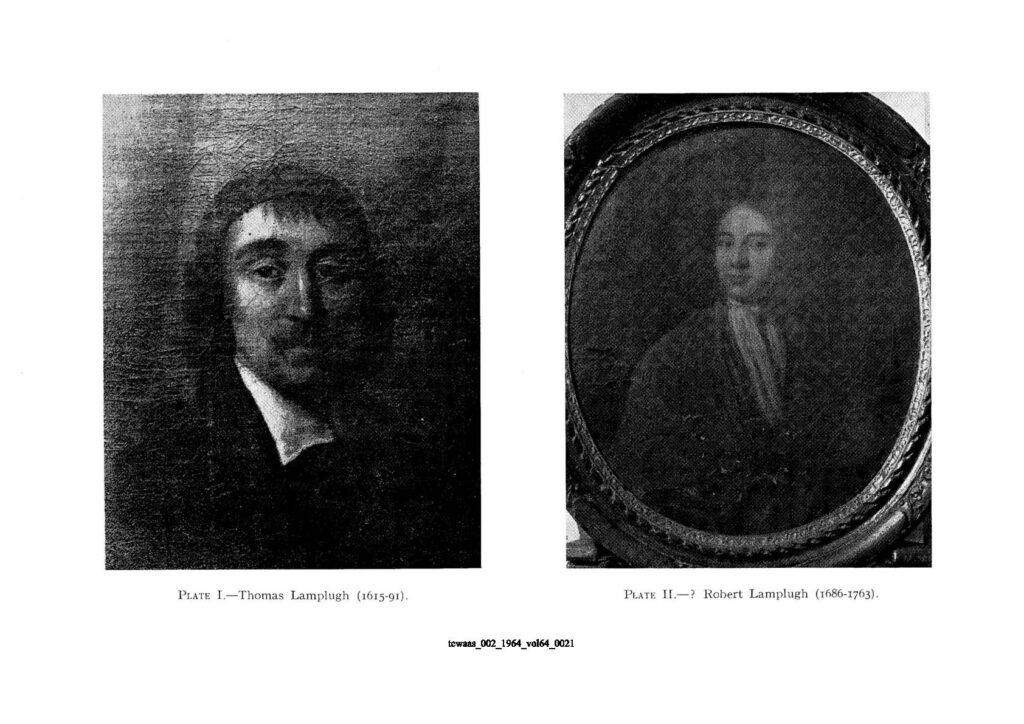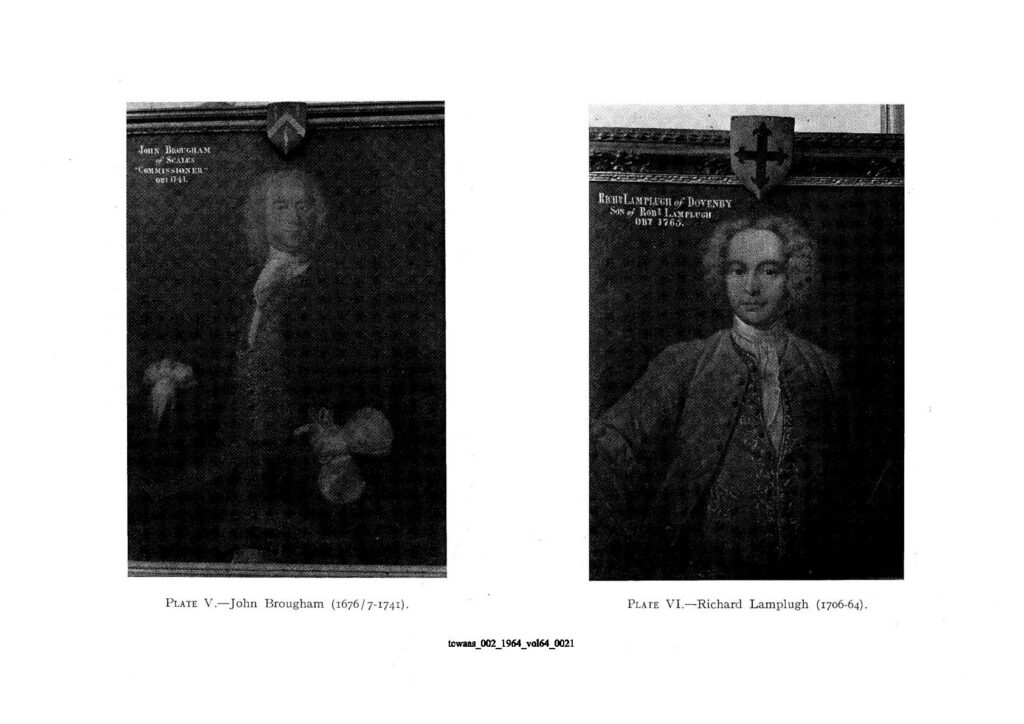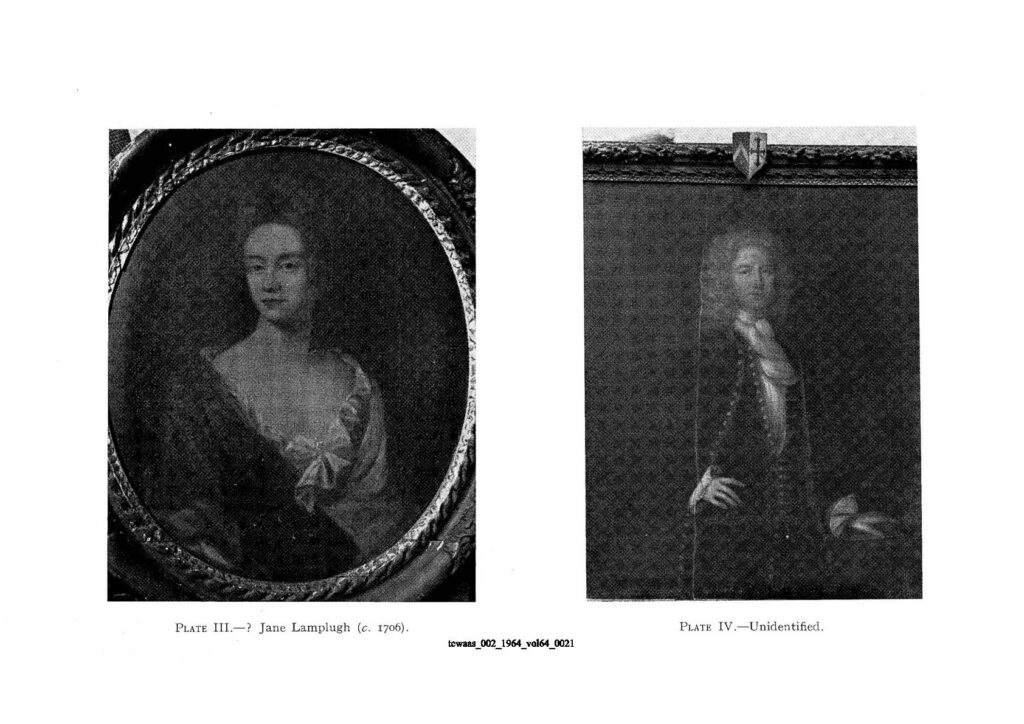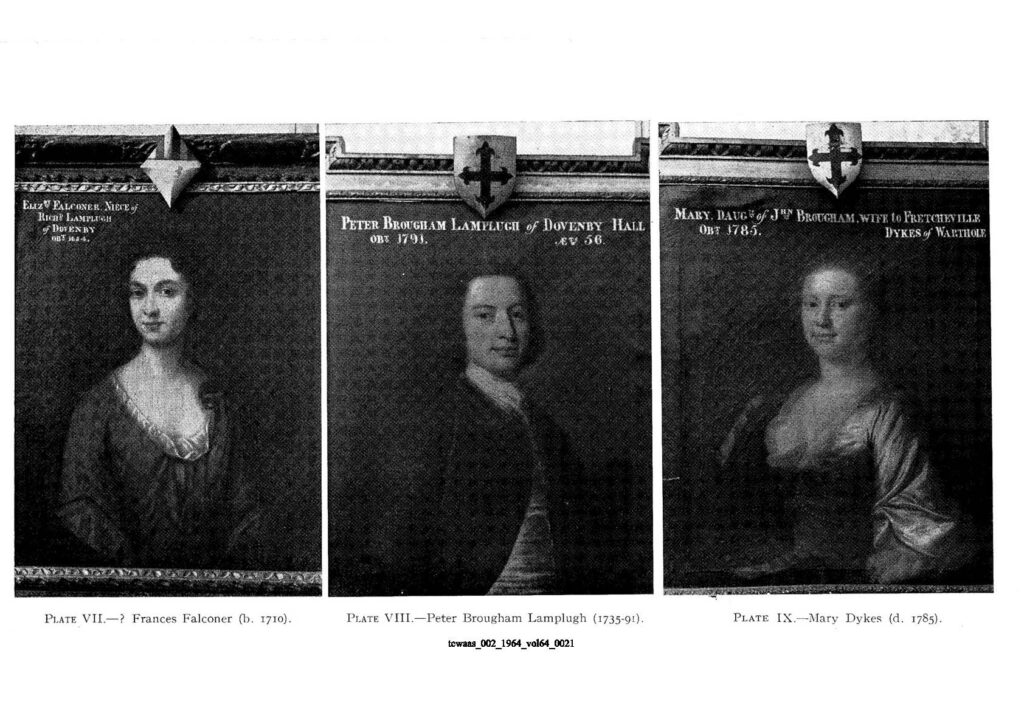Dovenby Hall 1600 to 1799
by A R Jabez Smith from CWAAS 1963
ALTHOUGH the object of this paper is to identity the subjects of some portraits seen by the members of the Society who visited Dovenby Hall last year, it will not be out of place to preface my notes on the portraits by an attempt to describe the complicated devolution of the manor and house of Dovenby during the 17th and 18th centuries, since it is with this period that the portraits are associated .
Dovenby appears to have come into the possession of the Lamplugh family by the marriage in about 1400 of a Kirkbride heiress with a younger brother of the Sir John Lamplugh of Lamplugh who was executed after Bramham Moor in 1405. [1]. It descended in the male line to Sir Thomas Lamplugh (1577 – 1632). He had no surviving issue. Although he was one of eight brothers, seven of whom survived infancy, by 1640 the re was no living descendant in the male line of any of the brothers .
The history of the manor and demesne of Dovenby from 1638, when Anthony Lamplugh, the last of Sir Thomas’s brothers died, until 1800, when the eventual heiress Mary Dykes married her cousin Joseph Dykes Ballantine, is confused and it is not easy to say who was in possession of the Hall at certain times during this period. The house and demesne did however remain in the family, although the manor was alienated for a time and later repurchased .
Sir Thomas Lamplugh left the house to his widow, Agnes, for life with reversion to his brother George. Most of his other property, including the manor of Dovenby, was left to George in tail male [sic] and in default of male issue to his brothers Anthony, William and Cuthbert and his kinsmen George and John Lamplugh of Papcastle all in tail male in succession. A careful reading of Sir Thomas’s will shows that there is ground for interpreting the will as not attaching the male entail to the house and certain other property left for life to Agnes and then to Thomas’s brother George. [2]
Dame Agnes Lamplugh did not die until 1665. As she had no life interest in the manor of Dovenby, that had passed on the death of Anthony in 1638 to George Lamplugh of Papcastle, the male entails in favour of William and Cuthbert having failed. George of Papcastle died in 1674. His son Thomas appears to have mortgaged the manor to the Cooke and Browne families who foreclosed. [3]. In the earlier part of the 18th century it was in the possession of the Cooke family, but was apparently repurchased by the Dovenby Lamplughs before 1769 and it formed part of Mary Dykes’s inheritance. [4]
On Dame Agnes’s death the house and demesne passed, if my interpretation of Sir Thomas’s will is correct, to the heirs of her brother-in-law George Lamplugh who had died in 1633. These heirs were descendants of his brother William Lamplugh, who had two daughters, Dorothy who married Edmund Winstanley and Frances who married William Bullock, and (ii) descendants of his sister Eleanor Lamplugh who had married Richard Tolson.
The Winstanleys and Tolsons seem to have been bought out (there was litigation), because by the 1680’S the house and demesne apparently belonged to two sisters and co·heiresses, Mary and Frances Molyne, grand daughters of Frances Lamplugh and William Bullock.
These two co-heiresses married Lamplughs of other branches. Mary married Richard Lamplugh I of Ribton (c. 1632-1734) as his second wife, and Frances married Thomas Lamplugh of Lamplugh (1656-1734), who, incidentally, was Richard’s nephew, being a son of Richard’s sister. Richard Lamplugh seems to have bought out his sister-in-law and her husband, because he devised the house and demesne by will to his wife Mary for life and then to their son Robert and the heirs of his body, in default to his son by his first wife, Richard, and the heirs of his body, in default to his brother-in-law Thomas Lamplugh of Lamplugh and the heirs of his body. [5]
After Richard’s death his widow , Mary, married Richard Goodman of Carlisle. She was buried at Bridekirk in 1736 and is described in the Register as “Mrs Goodman of Dovenby. “
After Mrs Goodman’s death the house and demesne passed to her son Robert Lamplugh (1686-1763) and after his death to his son Richard Lamplugh II (1706- 1764). It then passed to the latter’s niece, Elizabeth Falconer, who died in 1768 unmarried.
After Elizabeth Falconer’s death the house seems to have passed to Thomas Lamplugh of Lamplugh’s only surviving child, Mrs Elizabeth Irton (1701-1775). She probably inherited it under the terms of Richard Lamplugh I’s will, Robert’s issue and his half-brother Richard’s issue having failed. The view that her title was derived from Richard Lamplugh l ‘s will is supported by the fact that she did not inherit the Manor of Dovenby, which at the time of Richard ‘s death in 1704 was not owned by the family . Mrs Irton left a life interest in the house to the Reverend Thomas Lamplugh of Copgrove, Yorkshire, and then to his issue and in default to Peter Brougham, a grandson of Elizabeth, daughter of Richard Lamplugh of Ribton and Mary Molyne. [6]
The Reverend Thomas had no issue and Peter Brougham succeeded and assumed the arms and name of Lamplugh in 1783 [7] but died without issue in 1791. He had already succeeded to the manor of Dovenby on the death of Elizabeth Falconer, so the manor and house were reunited in him .
On Peter Brougham Lamplugh’s death Dovenby demesne and manor passed to his niece Mary Dykes to whose descendant, Capt. J. F. Ballantine-Dykes, the portraits now to be described belong.
Owners of the house from Sir Thomas’ death until 1800
By way of summarising the foregoing, it may help to tabulate the probable owners of the house from Sir Thomas’s death until 1800 .
1632 – 1665 Dame Agnes Lamplugh
1665 – c1680 Molyne Family
1680.- 1704 Richard and :Mary Lamplugh (born Molyne)
1704 – 1736 Mrs Mary Goodman (Iormerly Lamplugh)
1736- 1763 Robert Lamplugh, her son
1763 – 1764 Richard Lamplugh, his son
1764 – 1768 Elizabeth Falconer, his niece
1768 – 1775 Mrs Elizabeth Irton
1775 – 1783 Reverend Thomas Lamplugh of Copgrove
1783 – 1791 Peter Brougham Lamplugh
1791 onwards Ballantine-Dykes Family
The present house was probably built by Richard Lamplugh of Ribton after his marriage to Mary Molyne. It incorporates a medieval tower but is architecturally undistinguished and appears to have been altered from time to time_ Let into the garden wall of the house are a number of stone tablets carved with the arms of the Lamplughs and various connections. They antedate the house and presumably came from the earlier Dovenby Hall described fairly fully by Sir Thomas Lampugh in his will.
Notes on the Portraits
Mr Joseph Hughes has photographed the pictures and his photographs accompany this paper. I am indebted to him for supplying me with a set, to Captain Ballantine-Dykes for permission to publish them, to Mr Roy Hudleston for helping with identifications, and to Dr R. Strong of the National Portrait Gallery for advice on the probable dales of the pictures.
The inscriptions were obviously superimposed all at the same time and probably in the first quarter of the last century. As they are not contemporary with the portraits they must be accepted with reserve. The same applies to the shields and lozenges.
Portrait 1
This is without a doubt a portrait of THOMAS LAMPLUGH (1615 – 1691), ARCHBISHOP OF YORK 1688-1691.
It was probably painted between 1655 and 1660. The National Portrait Gallery have a photograph of a portrait of this Thomas Lamplugh dated about 1664. Until 1900 it was in the York Art Gallery and is now, I understand, in the possession of the Rt Rev. K. E. N. Lamplugh, Bishop Suffragan of Southampton.
That picture shows Thomas Lamplugh with a small beard, as does a portrait by Kneller dated 1689 at The Queen’s College, Oxford. I have a large engraving of the Kneller portrait by Vanderbank. The heavy eyebrows and long nose are the same in all three portraits which are obviously of the same man. A fine portrait of Thomas’s wife, Catherine Davenant, depicting her in a tall “witch’s” hat is believed to be still in York Art Gallery. From a photograph it appears to be a companion piece to the 1664 portrait.
Although the Dovenby portrait needs cleaning, it seems to be of fine quality. This picture may have been brought from Ribton by Thomas’s cousin, Richard Lamplugh of Ribton and Dovenby. There is reason to suppose that Thomas spent his childhood at Ribton. [note 8]
Portrait 2 and 3.
This pair of portraits are uninscribed. They seem to be of the Queen Anne period and the subjects each in their twenties. They may represent ROBERT LAMPLUGH OF DOVENBY (1686 – 1763) and his wife (and cousin), JANE LAMPLUGH OF LAMPLUGH whom he married in 1706. [note 9] The portraits may have been painted soon after the marriage.
Portrait 4.
This is a puzzle. The arms are those of Bullock impaling Lamplugh, but the only member of the Bullock family who married a Lamplugh was William Bullock (living in 1649) who married Frances, daughter of ‘William Lamplugh and a co-heiress of Dovenby Hall. This is certainly not the portrait of a man who lived in the middle of the 17th century. The costume indicates a date between 1720 and 1730. It might be Robert Lamplugh (born 1686) in middle age, but it must at the present time be recorded as . “unidentified” . Perhaps the shield was previously attached to a portrait of William Bullock. I understand that Captain Ballantine-Dykes possesses a portrait of William Bullock’s wife or daughter.
Portrait 5.
This portrait which was painted about 1738 may well be COMMISSIONER BROUGHAM (1676/7 – 1741). Although he had no direct connection with Dovenby Hall, his nephew John Brougham of Cockermouth (1705-1782) married a Dovenby heiress, Frances Woodhall, granddaughter of Richard Lamplugh of Ribton and Dovenby. The nephew was a beneficiary under the Commissioner’s will. [10]
Portrait 6
There is no reason to doubt that this is RICHARD LAMPLUGH (1706-1764) son of Robert Lamplugh of Dovenby, painted as a young man in about 1735.
The accompanying table shows the relationships of the subjects of the Dovenby portraits and other persons mentioned in this paper.
Portrait 7.
Dr Strong considers that the dress and hair style indicate that this picture cannot have been painted later than ]730. It cannot, therefore, be Elizabeth Falconer who died at an early age in 1768. Nor can it be the portrait of anyone who died in 1654, the date in the inscription. It might, however, be a portrait of Elizabeth’s mother, FRANCES FALCONER, sister of the subject of no. 6, whose features are very similar.
Frances was born in 1710 and as the portrait is of a very young woman it might well be of her when aged about 20. The lozenge attached to this portrait shows the arms of Keith. Whoever was responsible for the shields and lozenges probably looked up the arms of Falconer, found a quartered shield and picked out the wrong quartering. Frances Lamplugh who was probably unmarried when this portrait was painted married David (d. 1775) third son of David, fifth Lord Falconer of Halkerton (168I – 1751). [11]
Portrait 8.
I do not doubt that this is PETER BROUGHAM LAMPLUGH, son of John Brougham of Cockermouth . He assumed the surname and arms of Lamplugh in 1783 presumably in accordance with the name and arms clause in the will of Mrs Elizabeth Irton (born Elizabeth Lamplugh of Lamplugh), his first cousin twice removed, from whom he inherited Dovenby Hall.
Portrait 9·
This portrait is in exactly the same kind of frame as no. 8 and was almost certainly painted at the same time and by the same artist. It is therefore probably inscribed correctly and is Peter’s sister, MARY BROUGHAM (d. 1785), who married Frecheville Dykes. Her daughter inherited Dovenby on Peter’s death in 1791. Both portraits were painted about 1755. The shield on Mary’s portrait should. of course, be a lozenge and she was not entitled to bear the Lamplugh arms alone. Dr Strong considers these two portraits to be of fine quality and in the manner of Allan Ramsay.
It is of interest to note that Mrs Elizabeth Irton left all her plate, household goods and furniture “in my mansion house of Dovenby Hall” to the Reverend Thomas Lamplugh of Copgrove outright. 12 One would therefore have expected these portraits (other than those of the Brougham family) to have been in the possession of the Brooksbank family, the eventual heirs of the Reverend Thomas Lamplugh and the inheritors of Lamplugh Hall. Possibly the Broughams bought the contents of Dovenby Hall from Thomas Lamplugh’s executors.
References refer to italic numbers in the text.
1 For an account of the Lamplughs of Dovenby see Canon Taylor’s paper CW2 xxxix 71 et seq.
2 Ibid (same as ref 1) 98-100
3 Hutchinson ii 255; Ch Actions W. 127/60 (1675), W. 132/81 (1678) and c. 7 209/4 (1692)
4 CW2 xxxix 87
5 Richard Lamplugh’s will proved at York August 1705
6 CW2 xxxviii 127
7 Canon Taylor gives 1793 as the date of this Thomas Lamplugh’s death
but that is a mistake. He was buried at Copgrove, near Knaresborough .
Yorks on the 13th March 1783 – aged 55. There is a memorial in Copgrove Church which is:
“Sacred to the memory of the Reverend Thomas Lamplugh A.M Rector of this parish; Prebendary of Wistow in the Cathedral Church of York: Lord of the Manor of Lamplugh in Cumberland and last male heir of the ancient family of Lamplugh.
“He was the only son of the Reverend Thomas Lamplugh A .M. formerly Rector of Bolton Percy and one of the Canons residentiary of the said Cathedral Church by Honor his Wife the daughter of William Chaloner of Guisborough Esqr., He married Mary the daughter of Mr James Collins and died without issue 28th February 1783 aged 55 years.”]
8 CW2 xxxviii 108
9 Although the Bridekirk Register records the marriage on 26 March 1706 of “Mr Lamplugh of Dovenby and Grace Lamplugh”, I am sure that “Grace” is a mistake for “Jane”. The Lamplugh Register records the marriage on 1 June 1706 of “William Farish of Whitehaven and Grace of Lamplugh”. In Chancery Proceedings (H. 205/46 PRO) it is stated that Grace married William Feries and Jane married Robert Lamplugh of Dovenby. It is perhaps worth recording here, that Mary Lamplugh, another of the sisters (noted by Canon Taylor as “unmarried”), is stated in the same proceedings to have married John Lovett.
10 For the Brougham family and the Lamplugh connection see Mr Hudleston’s paper, CW2 lxi 131-168
11 Scots Peerage v




